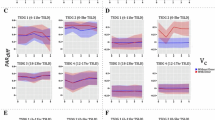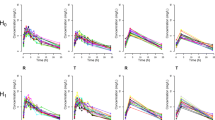Abstract
Purpose. To explore, by simulation procedures, the feasibility of characterizing, from sparse data, the concentration-effect relationship of drugs with pharmacodynamic hysteresis.
Methods. For computer simulations, the concentration-effect relationship was assumed to be describable by the Sigmoid-E max equation, the site of drug action was located in a distinct effect compartment (k eo = 10 × k elim), and the pharmacokinetics were those of either a linear one- or two-compartment system. In view of the poor estimability of the parameters of the Sigmoid-E max model under the usual clinical conditions, central compartment post-distributive drug concentrations required to elicit various intensities of effect within the therapeutic range were used as data descriptors. Effect intensities of 5 and 25, or 25 and 50 units (with the “unknown” E max = 100 units) were targeted in multiple-dose (steady state) trial designs. From these data, drug concentrations required to produce effect intensities of 15 and 50 units were estimated by both log-linear and linear interpolation and the actual effect intensities produced by these concentrations were calculated. These simulations were performed over a wide range of Hill coefficient values (0.5 to 4.0) and dosing intervals (0.1 to 1.5 × elimination t 1/2).
Results. Acceptable results could be obtained by measuring drug concentrations and effect intensities at or near the end of a dosing interval. The largest deviations of effective concentration estimates (in terms of effect intensity) occurred at a Hill coefficient value of 0.5 and the results were very little affected by changing the dosing interval.
Conclusions. Our results demonstrate that effect-controlled clinical trials, with sparse data, of drugs with pharmacodynamic hysteresis for determining concentration-effect relationship in the therapeutic range are feasible in principle.
Similar content being viewed by others
REFERENCES
G. Levy, W. F. Ebling and A. Forrest. Clin. Pharmacol. Ther. 56:1–8 (1994).
W. F. Ebling and G. Levy. Annals Pharmacother. 30:12–18 (1995).
T. Fullerton, A. Forrest and G. Levy. J. Pharm. Sci. 85:600–607 (1996).
C. C. Peck. Clin. Pharmacol. Ther. 53:385–387 (1993).
S. Dutta, Y. Matsumoto and W. F. Ebling. J. Pharm. Sci. 85:232–239 (1996).
L. B. Sheiner, D. R. Stanski, S. Vozeh, R. D. Miller and J. Ham. Clin. Pharmacol. Ther. 25:358–371 (1979).
D. R. Stanski. Annu. Rev. Pharmacol. Toxicol. 32:423–447 (1992).
D. Z. D'Argenio and A. Schumitzky. Computer Programs Biomed. 9:115–134 (1979).
D. Z. D'Argenio and A. Schumitzky. ADAPT II users guide. Los Angeles: Biomedical Simulations Resource, University of Southern California (1992).
J. B. Schwartz, D. Verotta and L. B. Sheiner. J. Pharmacol. Exp. Therap. 251:1032–1038 (1989).
R. Lapka, T. Sechser, V. Rejholec, M. Peterkova and M. Votavova. Eur. J. Clin. Pharmacol. 38:243–247 (1990).
A. O. Alradi and S. G. Carruthers. Clin. Pharmacol. Ther. 38:495–502 (1985).
M. Gibaldi and D. Perrier. Pharmacokinetics. Marcel Decker, New York (1975), pp. 48–55.
F. H. Dost. Der Blutspiegel. George Thieme Verlag, Leipzig, Germany (1953), pp. 252–255.
N. H. G. Holford and L. B. Sheiner. Clin. Pharmacokin. 6:429–453 (1981).
Author information
Authors and Affiliations
Rights and permissions
About this article
Cite this article
Ehling, W.E., Matsumoto, Y. & Levy, G. Feasibility of Effect-Controlled Clinical Trials of Drugs with Pharmacodynamic Hysteresis Using Sparse Data. Pharm Res 13, 1804–1810 (1996). https://doi.org/10.1023/A:1016072806164
Issue Date:
DOI: https://doi.org/10.1023/A:1016072806164




